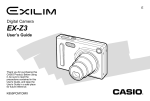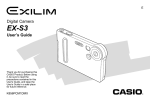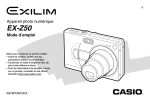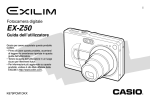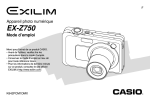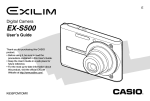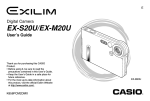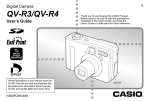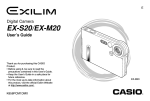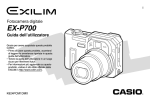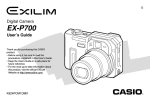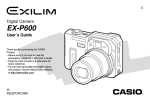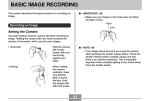Download Casio Exilim EX-Z4U User`s guide
Transcript
E Digital Camera EX-Z4U User’s Guide Thank you for purchasing this CASIO Product. • Before using it, be sure to read the precautions contained in this User’s Guide. • Keep the User’s Guide in a safe place for future reference. • For the most up-to-date information about this product, visit the official Exilim Website at http://www.exilim.com/. K857PCM2DMX INTRODUCTION INTRODUCTION Unpacking Check to make sure that all of the items shown below are included with your camera. If something is missing, contact your dealer as soon as possible. PHOTO CHARGE USB Camera Rechargeable lithium ion battery (NP-20) USB Cradle (CA-21A) Strap CD-ROM USB Cable Basic Reference Special AC Adaptor (AD-C51J) 2 INTRODUCTION 19 Contents GETTING READY About This Manual ..................................................... 19 I 2 General Guide ............................................................ 20 INTRODUCTION Camera USB Cradle Unpacking .................................................................... 2 Monitor Screen Contents ........................................... 22 Features ....................................................................... 9 REC mode PLAY mode Changing the Contents of the Monitor Screen Precautions ................................................................. 11 General Precautions Data Error Precautions Operating conditions Condensation Lens Other 15 20 21 11 13 13 14 14 14 22 24 25 Indicator Lamps .......................................................... 25 Attaching the Strap .................................................... 26 Power Requirements ................................................. 26 To load the battery To remove the battery To charge the battery Power Supply Precautions Turning the Camera On and Off Configuring Power Saving Settings QUICK START GUIDE First, charge the battery! ............................................ 15 To configure display language and clock settings ..... 16 26 28 28 32 36 36 Using the On-screen Menus ...................................... 37 To record an image .................................................... 17 Configuring Display Language and Clock Settings ... 40 To view a recorded image .......................................... 17 To configure display language and clock settings To delete an image ..................................................... 18 3 41 INTRODUCTION 43 Exposure Compensation (EV Shift) ........................... 64 BASIC IMAGE RECORDING Adjusting White Balance ............................................ 65 Recording an Image ................................................... 43 Aiming the Camera Recording an Image Recording Precautions About Auto Focus About the REC Mode Monitor Screen Adjusting White Balance Manually 66 43 44 46 47 47 Using the BESTSHOT Mode ..................................... 67 Using the Optical Viewfinder ...................................... 48 Recording a Subject onto an Existing Background Image (Pre-shot) ........................................................ 73 Creating Your Own BESTSHOT Setup Using Zoom ................................................................ 49 Optical Zoom Digital Zoom 49 50 Recording Audio ......................................................... 75 Adding Audio to a Snapshot Recording Your Voice Using the Flash .......................................................... 51 Flash Unit Status Flash Precautions 53 53 REC Mode Camera Settings ..................................... 79 Specifying ISO Sensitivity Turning the On-screen Grid On and Off Turning Image Review On and Off Assigning Functions to the [] and [] Keys Specifying Power On Default Settings Resetting the Camera Specifying Image Size and Quality ............................ 55 58 55 56 OTHER RECORDING FUNCTIONS Selecting the Focus Mode ......................................... 58 Using Auto Focus Using the Macro Mode Using the Pan Focus Mode Using the Infinity Mode Using Manual Focus Using Focus Lock 75 76 Using the Histogram .................................................. 78 Using the Self-timer ................................................... 54 To specify the image size To specify image quality 69 Combining Shots of Two People into a Single Image (Coupling Shot) ............................................... 71 58 60 60 61 62 63 4 80 81 81 82 83 84 INTRODUCTION 85 PLAYBACK 103 Basic Playback Operation .......................................... 85 Playing an Audio Snapshot DELETING FILES Deleting a Single File ............................................... 103 86 Deleting All Files ...................................................... 104 Flipping the Display .................................................... 87 Zooming the Display Image ....................................... 88 105 FILE MANAGEMENT Resizing an Image ..................................................... 89 Folders ..................................................................... 105 Cropping an Image ..................................................... 90 Memory Folders and Files Displaying the 9-image View ..................................... 91 Selecting a Specific Image in the 9-image View 92 To protect a single file To protect all files in memory Displaying the Calendar Screen ................................ 92 Playing a Slide Show ................................................. 93 To specify the slideshow images To specify the slideshow time To set the slideshow interval Using the Photo Stand Feature 105 Protecting Files ........................................................ 106 106 107 DPOF ........................................................................ 107 95 96 96 97 PRINT Image Matching II ............................................. 110 Rotating the Display Image ........................................ 98 Exif Print .................................................................... 110 Using Image Roulette ................................................ 99 Using USB DIRECT-PRINT ...................................... 111 Adding Audio to a Snapshot .................................... 100 Using the FAVORITE Folder ..................................... 113 To re-record audio To configure print settings for a single image To configure print settings for all images To To To To 101 Playing Back a Voice Recording File ....................... 102 5 copy a file to the FAVORITE folder display a file in the FAVORITE folder delete a file from the FAVORITE folder delete all files from the FAVORITE folder 108 109 113 114 115 116 INTRODUCTION 117 OTHER SETTINGS 130 Configuring Sound Settings ...................................... 117 To configure sound settings To set the volume level Using a Memory Card .............................................. 131 117 118 To insert a memory card into the camera To remove a memory card from the camera Formatting a Memory Card Memory Card Precautions Specifying an Image for the Startup Screen ............ 118 Configuring Power Down Image Settings ................. 119 131 132 132 133 Copying Files ........................................................... 134 Specifying the File Name Serial Number Generation Method .................................................. 121 To copy all the files in built-in memory to a memory card 134 To copy a file from a memory card to built-in memory 135 Using the Alarm ........................................................ 122 To set an alarm Stopping the Alarm USING A MEMORY CARD 122 123 136 VIEWING IMAGES ON A COMPUTER Setting the Clock ...................................................... 123 To select your Home Time zone To set the current time and date Changing the Date Format Using the Camera with a Windows Computer ........ 136 123 124 125 USB Connection Precautions Using World Time ..................................................... 125 To display the World Time screen To configure World Time settings To configure summer time (DST) settings 141 Using the Camera with a Macintosh Computer ....... 141 USB Connection Precautions 145 125 126 127 Operations You Can Perform from Your Computer .................................................................. 145 Changing the Display Language ............................. 128 Using a Memory Card to Transfer Images to a Computer .................................................................. 146 Formatting Built-in Memory ...................................... 128 Memory Data ............................................................ 147 DCF Protocol Memory Directory Structure Image Files Supported by the Camera Built-in Memory and Memory Card Precautions 6 147 147 149 149 INTRODUCTION 150 USING THE CAMERA WITH A COMPUTER 164 Using the Album Feature ......................................... 150 Creating an album Selecting an Album Layout Configuring Detailed Album Settings Viewing Album Files Saving an Album Menu Reference ....................................................... 164 150 151 152 154 157 Indicator Lamp Reference ....................................... 166 REC mode PLAY mode USB Cradle Indicator Lamps Display Messages 157 158 Main Specifications 159 160 160 161 161 161 Installing Software from the CD-ROM on a Macintosh .............................................................. 162 Installing Software Viewing User Documentation (PDF Files) 172 Specifications ........................................................... 173 Installing Software from the CD-ROM in Windows ............................................................... 159 Getting Started Viewing the Contents of the “Read me” File Installing an Application Viewing User Documentation (PDF Files) User Registration Exiting the Menu Application 167 168 168 Troubleshooting Guide ............................................. 169 Installing the Software from the CD-ROM ............... 157 About the bundled CD-ROM Computer System Requirements APPENDIX 162 163 7 173 INTRODUCTION • The USB driver (mass storage) uses Phoenix Technologies Ltd. software. Compatibility Software Copyright C 1997 Phoenix Technologies Ltd., All Rights Reserved. • Other company, product and service names used herein may also be trademarks or service marks of others. • Photo Loader and Photohands are the property of CASIO COMPUTER CO., LTD. Except as stipulated above, all copyrights and other related rights to these applications revert to CASIO COMPUTER CO., LTD. IMPORTANT! • The contents of this manual are subject to change without notice. • CASIO COMPUTER CO., LTD. assumes no responsibility for any damage or loss resulting from the use of this manual. • CASIO COMPUTER CO., LTD. assumes no responsibility for any loss or claims by third parties which may arise through the use of the EX-Z4U. • CASIO COMPUTER CO., LTD. shall not be held liable for any damages or losses suffered by you or any third party due to the use of Photo Loader and/or Photohands. • CASIO COMPUTER CO., LTD. assumes no responsibility for any damage or loss caused by deletion of data as a result of malfunction, repairs, or battery replacement. Be sure to back up all important data on other media to protect against its loss. • The SD logo is a registered trademark. • Windows, Internet Explorer, and DirectX are registered trademarks of Microsoft Corporation. • Macintosh is a registered trademark of Apple Computer, Inc. • MultiMediaCard is a trademark of Infineon Technologies AG of Germany, and licensed to the MultiMediaCard Association (MMCA). • Acrobat and Acrobat Reader are trademarks of Adobe Systems Incorporated. ■ Copyright Restrictions Except for the purposes of your own personal enjoyment, unauthorized copying of snapshot files and audio files violates copyright laws and international contracts. Distribution to third parties of such files over the Internet without permission of the copyright holder, whether for profit or for free, violates copyright laws and international contracts. 8 INTRODUCTION • Easy Image Transfer Transfer images to a computer simply by placing the camera onto the USB cradle. Features • 4.0 million Effective Pixels A high-resolution megapixel CCD provides 4.0 million effective pixels (4.23 million total pixels) for images that print beautifully. • Photo Stand feature A slideshow of images in file memory can be played while the camera is on its USB cradle. • 2.0-inch TFT color LCD monitor screen • BESTSHOT Simply select the sample scene that matches the type of image you are trying to record and the camera performs troublesome setups automatically for beautiful pictures every time. • 12X seamless zoom 3X optical zoom, 4X digital zoom • 10MB Flash memory Images can be recorded without using a memory card. • Coupling Shot and Pre-shot Coupling Shot lets you combine two subjects into a single image, while Pre-shot lets you add a subject to a previously recorded background image. This means you can create images that include you and your friend, even if you are the only two people around. You can use Coupling Shot and Pre-shot by selecting the applicable sample images in the BESTSHOT mode. • Multi Auto Focus When “Multi” is selected for the Auto Focus area, the camera takes simultaneous meter readings at seven different points and automatically selects the best one. This makes it possible to avoid erroneous focusing on the background, and ensure proper focus for a wide range of image types. • Pan Focus This feature lets you lock the focus point and ensures that you do not miss that special moment when it happens. • Image Roulette Feature Images cycle like a slot machine on the display until one of them remains. • Support for SD memory cards and MMC (MultiMedia Cards) for memory expansion • Triple Self-timer mode The self-timer can be set up to repeat three times, automatically. • Easy Charging Just place the camera onto the USB cradle to charge its battery. 9 INTRODUCTION • Voice Recording Quick and easy recording of voice input. • Real-time histogram An on-screen histogram lets you adjust exposure as you view the effect on overall image brightness, which makes shooting under difficult lighting conditions easier than ever before. • After Recording Adds audio to images after they are recorded. • Selectable Sound Settings You can configure different sounds to play whenever you turn on the camera, press the shutter release button halfway or all the way, or perform a key operation. • World Time A simple operation sets the current time for your current location. You can select from among 162 cities in 32 time zones. • DCF Data Storage DCF (Design rule for Camera File system) data storage protocol provides image inter-compatibility between the digital camera and printers. • Alarm A built-in alarm helps to keep you on time for important events, and even can be used in place of an alarm clock. You can also have a specific image appear, or an audio file to play when the alarm time is reached. • Digital Print Order Format (DPOF) Images can be printed easily in the sequence you want using a DPOF compatible printer. DPOF can also be used when specifying images and quantities for printing by professional print services. • Album Function HTML files are generated automatically to create an album of recorded images. Album contents can be viewed and printed using a standard Web browser. Images can also be incorporated into Web pages quickly and easily. • PRINT Image Matching II Compatible Images include PRINT Image Matching II data (mode setting and other camera setup information). A printer that supports PRINT Image Matching II reads this data and adjusts the printed image accordingly, so your images come out just the way you intended when you recorded them. • Calendar screen A simple operation displays a full-month calendar on the camera’s monitor screen. Each day of the full-month calendar shows a thumbnail of the first image recorded for that date, which helps to make searching for a particular image quicker and easier. • Snapshot + Audio Mode Adds audio to a snapshot. 10 INTRODUCTION • USB DIRECT-PRINT support Your camera supports USB DIRECT-PRINT, which was developed by Seiko Epson Corporation. When connected directly to a printer that supports USB DIRECT-PRINT, you can select images to print and start the print operation directly from the camera. Precautions General Precautions Be sure to observe the following important precautions whenever using the EX-Z4U. • Bundled with Photo Loader and Photohands Your camera comes bundled with Photo Loader, the popular application that automatically loads images from your camera to your PC. It also comes with Photohands, and application that makes image retouching quick and easy. All references in this manual to “this camera” and “the camera” refer to the CASIO EX-Z4U Digital Camera. • Never try to take pictures or use the built-in display while operating a motor vehicle or while walking. Doing so creates the danger of serious accident. • Never try to open the case of the camera or attempt your own repairs. High-voltage internal components create the risk of electric shock when exposed. Always leave maintenance and repair work up to a CASIO authorized service center. • Never look at the sun or any other bright light through the camera’s viewfinder. Doing so can damage your eyesight. • Keep the small parts and accessories of this camera out of the reach of small children. If swallowed accidentally, contact your physician immediately. • Never fire the flash in the direction of a person operating a motor vehicle. Doing so can interfere with the driver’s vision and create the danger of accident. 11 INTRODUCTION • Never fire the flash while it is too close to the subject’s eyes. Intense light from the flash can cause eye damage if it is fired too close to the eyes. This is especially true with young children. When using the flash, the camera should be at least one meter (3.3´) from the eyes of the subject. • Keep the camera away from water and other liquids, and never let it get wet. Moisture creates the danger of fire and electric shock. Never use the camera outdoors in the rain or snow, at the seashore or beach, in the bathroom, etc. • Should foreign matter or water ever get into the camera, immediately turn it off. Next, remove the camera’s battery and/or unplug the AC adaptor power cord from the power outlet, and contact your dealer or nearest CASIO authorized service center. Using the camera under these conditions creates the danger of fire and electric shock. • Should you ever notice smoke or a strange odor coming out of the camera, immediately turn it off. Next, taking care you do not burn your fingers, remove the camera’s battery and/or unplug the AC adaptor power cord from the power outlet, and contact your dealer or nearest CASIO authorized service center. Using the camera under these conditions creates the danger of fire and electric shock. After making sure there is no more smoke coming from the camera, take it to your nearest CASIO authorized service center for repair. Never attempt your own maintenance. • Never use the AC adaptor to power any other device besides this camera. Never use any other AC adaptor besides the one that comes with this camera. • Never cover the AC adaptor with a quilt, blanket, or other cover while it is in use, and do not use it near a heater. • At least once a year, unplug the AC adaptor power cord from the power outlet and clean the area around the prongs of the plug. Dust build up around the prongs can create the danger of fire. • If the camera’s case should ever become cracked due to dropping it or otherwise subjecting it to rough treatment, immediately turn it off. Next, remove the camera’s battery and/or unplug the AC adaptor power cord from the power outlet, and contact your dealer or nearest CASIO authorized service center. • Never use the camera inside of an aircraft or in any other areas where its use is prohibited. Doing so can result in an accident. • Physical damage and malfunction of this camera can cause the data stored in its memory to be deleted. Be sure to always keep backup copies of data by transferring them to personal computer memory. • Never open the battery compartment cover, disconnect the AC adaptor from the camera, or unplug the AC adaptor from the wall socket while recording images. Doing so will not only make storage of the current image impossible, it can also corrupt other image data already stored in file memory. 12 INTRODUCTION Data Error Precautions Operating conditions • Your digital camera is manufactured using precision digital components. Any of the following creates the risk of corruption of data in file memory. • This camera is designed for use in temperatures ranging from 0°C to 40°C (32°F to 104°F). • Do not use or keep the camera in the following areas. — In areas subject to direct sunlight — In areas subject to high humidity or dust — Near air conditioners, heaters, or other areas subject to temperature extremes — Inside of a closed vehicle, especially one parked in the sun — In areas subject to strong vibration — Removing the battery or memory card, or setting the camera onto the USB cradle while the camera is performing a record or memory access operation — Removing the battery, removing the memory card, or placing the camera onto the USB cradle while the operation lamp is still flashing after you turn off the camera — Disconnecting the USB cable, removing the camera from the USB cradle, or disconnecting the AC adaptor from the USB cradle while a data communication operation is being performed — Low battery power — Other abnormal operations Any of the above conditions can cause an error message to appear on the monitor screen (page 172). Follow the instructions provided by the message to eliminate the cause of the error. 13 INTRODUCTION Condensation Lens • When you bring the camera indoors on a cold day or otherwise expose it to a sudden change of temperature, there is the possibility that condensation can form on the exterior or on interior components. Condensation can cause malfunction of the camera, so you should avoid exposing it to conditions that might cause condensation. • To keep condensation from forming, place the camera into a plastic bag before moving it into a location that is much warmer or colder than your current location. Leave it in the plastic bag until the air inside the bag has a chance to reach the same temperature as the new location. If condensation does form, remove the battery from the camera and leave the battery compartment cover open for a few hours. • Never apply too much force when cleaning the surface of the lens. Doing so can scratch the lens surface and cause malfunction. • Fingerprints, dust, or any other soiling of the lens can interfere with proper image recording. Never touch the lens with your fingers. You can remove dust particles from the lens surface by using a lens blower to blow them off. Next, wipe the surface of the lens with a soft lens cloth. Other • The camera may become slightly warm during use. This does not indicate malfunction. • If the exterior of the camera needs cleaning, wipe it with a soft, dry cloth. 14 QUICK START GUIDE QUICK START GUIDE First, charge the battery! 1. Load the battery (page 26). 2. Place the camera onto the USB cradle to charge the battery (page 28). 1 • It takes about two hours to achieve a full charge. 1 Stopper 2 2 PLAY REC MEN 3 SET DISP PHOT O 15 CHAR GE USB U QUICK START GUIDE To configure display language and clock settings • Be sure to configure the following settings before using the camera to record images. (See page 40 for details.) 1. Press the power button to turn on the camera. 2. Press [] to select the language you want. 1 3. Press [SET] to register the language setting. 4. Use [], [], [], and [] to select the geographical PLAY REC MENU SET DISP 2, 3, 4, 5, 6, 7, 8, 9 area you want, and then press [SET]. 5. Use [] and [] to select the city you want, and then press [SET]. 6. Use [] and [] to select the summer time (DST) setting you want, and then press [SET]. 7. Use [] and [] to select the date format setting you want, and then press [SET]. 8. Set the date and the time. 9. Press [SET] to register the clock settings and exit the setting screen. 16 QUICK START GUIDE To record an image To view a recorded image (See page 43 for details.) Green operation lamp 2 1 4 (See page 85 for details.) 2 1 99 1600 1200 NORMAL IN 1 / 1000 F2.6 PLAY 03/12 03 12/24 24 12:58 12 58 PLAY REC REC MENU MENU SET 3 SET Focus frame DISP DISP 3 1. Press the power button to turn on the camera. 1. Press the power button to turn on the camera. 2. Align the mode selector with “REC”. 3. Point the camera at the subject, use the monitor screen or viewfinder to compose the image, and then press the shutter release button half way. • When proper focus is achieved, the focus frame turns green and the green operation lamp lights. 4. Holding the camera still, gently press the shutter release button. 17 2. Align the mode selector with “PLAY”. 3. Use [] and [] to scroll through the images. QUICK START GUIDE To delete an image (See page 103 for details.) 2 1 PLAY REC MENU SET DISP 3, 4, 5, 6 1. Press the power button to turn on the camera. 2. Align the mode selector with “PLAY”. 3. Press [] ( ). 4. Use [] and [] to display the image you want to delete. 5. Use [] and [] to select “Delete”. • To exit the image delete operation without deleting anything, select “Cancel”. 6. Press [SET] to delete the image. 18 GETTING READY GETTING READY ■ Button Operations This section contains information about things you need to know about and do before trying to use the camera. Button operations are indicated by the button name inside of brackets ([ ]). About This Manual ■ On-screen Text This section contains information about the conventions used in this manual. On-screen text is always enclosed by double quotation marks (“ ”). ■ Terminology ■ File Memory The following table defines the terminology used in this manual. This term as used in this manual: Means this: “this camera” or “the camera” The CASIO EX-Z4U Digital Camera “file memory” The location where the camera is currently storing images you record (page 44) “battery” The NP-20 Rechargeable Lithium Ion Battery “optional charger unit” The optionally available CASIO BC-10L Charger Unit The term “file memory” in this manual is a general term that refers to the location where your camera is currently storing the images you record. File memory can be any one of the following three locations. • The camera’s built-in Flash memory • An SD memory card loaded in the camera • A MultiMediaCard loaded in the camera For more information about how the camera stores images, see page 130. 19 GETTING READY General Guide The following illustrations show the names of each component, button, and switch on the camera. Camera ■ Front 12 34 ■ Back 7 8 90 A 1 Shutter release button 2 Power button 3 Flash 4 Self-timer lamp 5 Microphone 6 Lens B PLAY REC MENU SET G 5 6 20 DISP F E D C 7 Viewfinder 8 Operation lamp 9 Mode selector 0 [MENU] button A Zoom button B Strap ring C [SET] button D [][][][] E [DISP] button F Monitor Screen G Speaker GETTING READY ■ Bottom USB Cradle Simply placing your CASIO digital camera onto the USB cradle lets you perform the following tasks. • Battery charging (page 28) • Automatic transfer of images to a computer (page 136) • Viewing of images using the Photo Stand slideshow feature (page 97). H I J ■ Front H Battery compartment cover I Connector J Tripod screw hole 12 3 * Use this hole when attaching to a tripod. PHOT O K CHAR GE USB 1 Camera connector 2 [USB] lamp 3 [USB] button 4 [CHARGE] lamp 5 [PHOTO] button 5 4 ■ Back 6 [DC IN 5.3V] K Stopper L Battery compartment M Memory card slot (AC adaptor connector) L 7 [USB] 6 7 M 21 (USB port) GETTING READY Monitor Screen Contents The monitor screen uses various indicators and icons to keep you informed of the camera’s status. REC mode 1 2 34 5 1 Flash Mode indicator 6 None Auto 4 Self-timer None Flash Off C 7 Flash On 8 Red-eye reduction 9 0 • If the camera detects that flash is required while auto flash is selected, the flash on indicator will appear when the shutter release button is pressed half way. 2 Focus Mode indicator None B A 2s Self-timer 2 sec 0 Date and time x3 Triple self-timer A EV value 5 REC modes Snapshot BESTSHOT Snapshot Audio (Remaining number of storable images) Infinity Manual Focus 7 Image size 3 White balance indicator Auto Sunlight Shade 2304 ҂ 1728 pixels 2304 ҂ 1536 (3:2) pixels 1600 ҂ 1200 pixels 1280 ҂ 960 pixels 640 ҂ 480 pixels 8 Quality Light Bulb FINE NORMAL ECONOMY Fluorescent Manual 22 Built-in memory selected for data storage. Memory card selected for data storage. Self-timer 10 sec 6 Memory capacity Pan Focus 9 10s Voice Recording Auto Focus Macro None 1-Image B Battery capacity C Focus frame • Focusing complete: Green • Focusing failed: Red GETTING READY D D Digital zoom indicator E Shutter speed value E F G • An out of range aperture or shutter speed causes the corresponding monitor screen value to turn amber. F Aperture value G ISO sensitivity H H Zoom indicator • Left side indicates optical zoom. • Right side indicates digital zoom. 23 GETTING READY PLAY mode 12 3 4 1 PLAY mode file type 5 Voice Recording 2 Image protection indicator 8 FINE NORMAL ECONOMY Snapshot Audio 6 7 5 Quality Snapshot 6 Built-in memory selected for data storage. Memory card selected for data storage. 3 Folder number/File number 7 Date and time 4 Image size 8 Battery capacity 2304 2304 1600 1280 640 ҂ 1728 pixels ҂ 1536 (3:2) pixels ҂ 1200 pixels ҂ 960 pixels ҂ 480 pixels 24 IMPORTANT! • Some information may not display properly if you display an image that was recorded using a different digital camera model. GETTING READY Changing the Contents of the Monitor Screen Indicator Lamps You can find out the operational status of the camera and the USB cradle at a glance by checking the color of the indicator lamps, and whether a lamp is lit or flashing. For details, see “Indicator Lamp Reference” on page 166. Each press of the [DISP] button changes the contents of the monitor screen as shown below. Indicators on (page 22) Histogram on (page 78) Indicators off Monitor screen off Self-timer lamp Green operation lamp PLAY REC MENU IMPORTANT! • You cannot turn off the monitor screen in the following cases: In the PLAY mode, in the BESTSHOT mode. • You cannot use the [DISP] button to change the contents of the monitor screen while standing by for or performing audio recording. • In the Voice Recording mode, you can only turn indicators on and off. SET DISP Red operation lamp [USB] lamp PHOT O CHAR GE USB [CHARGE] lamp 25 GETTING READY Attaching the Strap Power Requirements Attach the strap to the strap ring as shown in the illustration. Your camera is powered by a rechargeable lithium ion battery (NP-20). To load the battery PLAY REC 1. While pressing the battery compartment MENU cover on the bottom of the camera, slide the cover in the direction indicated by the arrow, and then swing it open. SET DISP PLAY REC MENU SET DISP IMPORTANT! • Be sure to keep the strap around your wrist when using the camera to protect against accidentally dropping it. • The supplied strap is intended for use with this camera only. Do not use it for any other purpose. • Never swing the camera around by the strap. 26 GETTING READY 2. While pulling the stopper in the direction 3. Swing the battery compartment cover closed, indicated by the arrow in the illustration, align the arrow mark on the battery with the arrow mark on the camera and slide the battery into the camera. and then slide it in the direction indicated by the arrow. Stopper IMPORTANT! • Use only the special NP-20 rechargeable lithium ion battery to power this camera. Use of any other type of battery is not supported. Arrow marks The battery is not charged when you purchase the camera. You need to charge the battery before using the camera for the first time (page 28). NP-20 • Push the bottom of the battery, and make sure that the stopper securely locks the battery in place. 27 GETTING READY To remove the battery To charge the battery 1. Open the battery compartment cover. 1. Connect the bundled AC adaptor to the [DC IN 5.3V] connector of the USB cradle. 2. Pull the stopper in the direction indicated by 2. Extend the prongs of the AC adaptor, and the arrow. then plug it into a household power outlet. • This will cause the battery to come part way out of the slot. Stopper [DC IN 5.3V] USB cradle AC Adaptor 3. Release the stopper and pull the battery from the camera. • Take care so you do not drop the battery. 28 GETTING READY 3. Turn off the camera. IMPORTANT! • It takes about two hours to achieve a full charge. Actual charging time depends on current battery capacity and charging conditions. • Use only the USB cradle (CA-21A) that comes with the camera, the optionally available USB cradle (CA21), or the optionally available charger unit (BC-10L) to charge the special NP-20 rechargeable lithium ion battery. Never use any other charging device. • Use only the bundled AC adaptor. Never use any other type of AC adaptor. Do not use optionally available AD-C40, AD-C620 and AD-C630 AC adaptors with this camera. • Make sure that the camera connector of the USB cradle is securely inserted into the camera’s connector as far as it will go. • The [CHARGE] lamp may remain amber colored and the charge operation may not start right away if you try to charge immediately after using the camera (which causes battery to become warm) or when it is too hot or too cold where you are performing the charge operation. If this happens, simply wait until the battery reaches normal temperature. The [CHARGE] lamp will turn red and charging will start when the battery temperature returns to the allowable charging temperature range. 4. Set the camera onto the USB cradle. PLAY REC • Do not place the camera onto the USB cradle while it is turned on. • The [CHARGE] lamp on the USB cradle should turn red, indicating that charging has started. When charging is complete, the [CHARGE] lamp will turn green. MEN U SET DISP PHOT O CHAR GE USB [CHARGE] lamp 5. After charging is complete, remove the camera from the USB cradle. 29 GETTING READY ■ If the camera works normally • If the [CHARGE] lamp starts flashing red, it means that an error occurs while charging. An error can be caused by any of the following: a problem with the USB cradle, a problem with the camera, or a problem with the battery or how it is loaded. Remove the camera from the USB cradle and see if it works normally. • You can use the USB cradle to charge the camera’s battery, to exchange data with a computer over a USB connection, or when using the Photo Stand feature only. 1. Continue using the camera until the current charge is used up, and then charge the battery. ■ If the camera does not work normally This can mean there is a problem with how the battery is loaded. NOTE 1. Remove the battery from the camera and • The AC adaptor is designed for operation on power ranging from 100V AC to 240V AC. Note, however, that the shape of the power cord plug varies according to country or geographic area. It is up to you to find out if the shape of the AC adaptor power cord plug is compatible with local power outlets when traveling abroad. check the battery contacts for dirt. If the contacts are dirty, wipe them clean with a dry cloth. 2. Check to make sure that the AC adaptor’s power cord is connected securely to the power outlet and USB cradle. • If the same symptoms occur again when you place the camera on the USB cradle after taking the above steps, contact a CASIO authorized service center. 30 GETTING READY ■ Battery Life Guidelines *2 Normal Recording Conditions • Temperature: 23°C (73°F) • Monitor Screen: On • Zoom operation between full wide to full telephoto every 30 seconds, during which two images are recorded, one image with flash; power turned off and back on every time 10 images are recorded. The battery life guideline values given below indicate the amount of time under the conditions defined below the table, until power automatically turns off due to battery failure. They do not guarantee that the battery will provide the amount of service indicated. Low temperatures and continued use reduce battery life. Operation *3 Continuous Playback Conditions • Temperature: 23°C (73°F) • Scroll one image about every 10 seconds Approximate Battery Life Number of Shots, Continuous Recording*1 (Recording Time) 540 shots (90 minutes) Number of Shots, Normal Recording*2 (Recording Time) 140 shots (70 minutes) Continuous Playback*3 (Continuous Snapshot Recording) 150 minutes Continuous Voice Recording*4 130 minutes *4 Voice recording times are based on continuous recording. • The above values are based on a new battery starting from a full charge. Repeated charging shortens battery life. • Battery life is greatly affected by how much you use flash, zoom and other functions, and how long you leave power turned on. Supported Battery: NP-20 (Rated Capacitance: 680mAh) *1 Continuous Recording Conditions • Temperature: 23°C (73°F) • Monitor screen: On • Flash: Off • Image recorded about every 10 seconds 31 GETTING READY ■ Tip to Make the Battery Last Longer Power Supply Precautions • If you do not need the flash while recording, select (flash off) for the flash mode. See page 51 for more information. • You can also conserve battery power by using the [DISP] button to turn off the monitor screen. Note the following precautions when handling or using the battery and the optional charger unit. ■ Battery Handling Precautions ● SAFETY PRECAUTIONS Be sure to read the following Safety Precautions before trying to use the battery for the first time. Keep these safety precautions and all operating instructions on hand for future reference. ■ Low Battery Indicator The following shows how the battery capacity indicator on the monitor screen changes as battery power is used. The indicator means that remaining battery power is low. Note that you will not be able to record images while the battery indicator is . Charge the battery immediately whenever either of these indicators appears. Battery Level High NOTES • The term “battery” in this manual refers to the CASIO NP-20 Rechargeable Lithium Ion Battery. • Use only the USB cradle (CA-21A) that comes with the camera, the optionally available USB cradle (CA21), or the optionally available charger unit (BC-10L) to charge the special NP-20 rechargeable lithium ion battery. Never use any other charging device. Low Indicator 32 GETTING READY • Failure to observe any of the following precautions while using the battery creates the risk of overheating, fire, and explosion. — Never use any other type of charger except the optional charger unit specified for the battery. — Never try to use the battery to power any other device other than this camera. — Never use or leave the battery near open flame. — Never place the battery in a microwave oven, throw it into fire, or otherwise expose it to intense heat. — Make sure the battery is oriented correctly when you load it into the camera or attach it to the optional charger unit. — Never carry or store the battery together with items that can conduct electricity (necklaces, pencil lead, etc.) — Never try to take the battery apart, modify it in any way, or expose it to strong impact. — Do not immerse the battery in fresh water or salt water. — Do not use or leave the battery under direct sunlight, in an automobile parked in the sun, or in any other area subject to high temperatures. • Should you ever notice leakage, strange odor, heat generation, discoloration, deformation, or any other abnormal condition while using, charging, or storing a battery, immediately remove it from the camera or optional charger unit and keep it away from open flame. • If the battery does not achieve full charge after the normal charging time has passed, stop charging. Continued charging creates the risk of overheating, fire, and explosion. • Battery fluid can damage your eyes. Should battery fluid get into your eyes accidentally, immediately rinse them with clean tap water and then consult a physician. • Be sure to read page 28 of this User’s Guide and the instructions that come with the optional charger unit before using or charging the battery. • If the battery is to be used by young children, make sure that a responsible adult makes them aware of the precautions and proper handling instructions and make sure that they handle the battery correctly. • Should fluid from the battery accidentally get onto clothing or your skin, immediately rinse it off with clean tap water. Prolonged contact with battery fluid can cause skin irritation. 33 GETTING READY ● PRECAUTIONS DURING USE ● BATTERY STORAGE PRECAUTIONS • The battery is designed for use with this CASIO digital camera only. • Use only the USB cradle that comes with the camera or the specified optional charger unit to charge the battery. Never use any other type of charger unit for charging. • A new battery is not charged. Be sure to charge the battery before using it for the first time. • Use of a battery in cold environments shortens the operating time you can expect on a full charge. Charge the battery in a location where the temperature is in the range of 10°C to 35°C (50°F to 95°F). Charging outside this temperature range can cause charging to take longer than normal or even cause charging to fail. • Very limited operation following a full charge indicates that the battery has reached the end of its service life. Replace the battery with a new one. • Never wipe the battery with thinner, benzene, alcohol, or other volatile agents or chemically treated rags. Doing so can cause deformation of the battery and lead to malfunction. • Make sure you remove the battery when you do not plan to use the camera for a long time. A battery left in the camera discharges very small amounts of power even when power is turned off, which can lead to a dead battery or the need for longer charging before the next use. • Store the battery in a cool, dry place (20°C (68 °F) or lower). ● USING THE BATTERY • See page 28 of this manual or the instructions that come with the optional charger unit for information about charging procedures and charging times. • When transporting a battery, keep it either loaded in the camera or stored in its case. 34 GETTING READY ■ USB Cradle and AC Adaptor Precautions Caution! • Never use an electrical outlet whose voltage is outside the rating marked on the AC adaptor. Doing so can create the danger of fire or electric shock. Use only the bundled AC adaptor specified for this camera. • Do not allow the AC adaptor cord to become cut or damaged, do not place heavy objects on it, and keep it away from heat. A damaged power cord creates the risk of fire and electric shock. • Never try to modify the AC adaptor cord, or subject it to severe bending, twisting, or pulling. Doing so creates the risk of fire and electric shock. • Never touch the AC adaptor while your hands are wet. Doing so creates the risk of electric shock. • Do not overload extension cords or wall outlets. Doing so creates the danger of fire and electric shock. • Should the cord of the AC adaptor become damaged (exposed internal wiring), request a replacement from a CASIO authorized service center. A damaged AC adaptor cord creates the danger of fire or electric shock. Caution! • Use the AC adaptor where it will not be splashed with water. Water creates the risk of fire and electric shock. • Do not place a vase or any other container filled with liquid on top of the AC adaptor. Water creates the risk of fire and electric shock. • Make sure you always remove the camera from the USB cradle before connecting or disconnecting the AC adaptor. • Charging, USB data communication, and using the Photo Stand feature can cause the AC adaptor to become warm. This is normal and does not indicate malfunction. • Unplug the AC power cord from the power outlet whenever you are not using it. • Never place a blanket or any other cover on the AC adaptor. Doing so creates the risk of fire. 35 GETTING READY Turning the Camera On and Off Configuring Power Saving Settings Press the power button to turn the camera on and off. Pressing the power button to turn on the camera causes the green operation lamp to light temporarily. Press the power button again to turn off the camera. You can configure the settings described below to conserve battery power. Sleep : Automatically turns off the monitor screen if no operation is performed for a specified amount of time in the REC mode. Performing any button operation causes the monitor screen to turn back on. Auto Power Off : Turns off power if you do not perform any operation for a specified amount of time. ON/OFF Power button Green operation lamp 1. Turn on the camera, and then align the mode selector with “REC” or “PLAY”. IMPORTANT! 2. Press [MENU]. • If camera power is turned off by the Auto Power Off feature, press the power button to turn it back on again. • Turning on camera power while the REC mode is selected by the mode selector causes the lens to extend from the camera. Make sure there is nothing in front of the camera that can be hit by the lens when you turn on the camera. 3. Use [] and [] to select the “Set Up” tab. 4. Use [] and [] to select the feature whose setting you want to configure, and then press [SET]. 36 GETTING READY ● See page 37 for information about how to use menus. To configure this feature: Select this setting: Sleep Sleep Auto Power Off Auto Power Off Using the On-screen Menus Pressing [MENU] displays menus on the monitor screen that you can use to perform various operations. The menu that appears depends on whether you are in the REC mode or the PLAY mode. The following shows an example menu procedure in the REC mode. 5. Use [] and [] to change the currently 1. Turn on the camera, selected setting, and then press [SET]. and then align the mode selector with “REC” to enter the REC mode. • Available Sleep settings are: “30 sec”, “1 min”, “2 min”, and “Off”. • Available Auto Power Off settings are: “2 min” and “5 min”. • If you want to enter the PLAY mode instead, you would align the mode selector with “PLAY”. • Note that the Sleep feature does not operate in the PLAY mode. • Pressing any button while the camera is in the Sleep state immediately turns the monitor screen back on. • The Auto Power Off and Sleep features are disabled in the following cases. — When the camera is connected to a computer or some other device through the USB cradle — While a slideshow is in progress — While playing back a voice recording file 37 Mode selector PLAY REC MENU GETTING READY ● Menu Screen Operations 2. Press [MENU]. Tab MENU [MENU] SET [SET] DISP [][ ][][ ] Settings Selection cursor (indicates the currently selected item) 38 When you want to do this: Do this: Move between tabs Press [] and []. Move from the tab to the settings Press []. Move from the settings to the tab Press []. Move between the settings Press [] and []. Display the options available for a setting Press [] or press [SET]. Select an option Press [] and []. Register an option selection and exit the menu screen Press [SET]. Register an option selection and return to the menu screen Press []. Exit the menu screen Press the [MENU] button. GETTING READY 3. Press [] or [] to select the tab you want, 6. Perform one of the following operations to and then press [SET] to move the selection cursor from the tab to the settings. apply the setting you configured. 4. Use [] and [] to select the feature whose setting you want to configure, and then press []. • Instead of pressing [], you could also press [SET]. Example: To select the “REC Mode” item. To do this: Perform this key operation: Apply the setting and exit the menu screen. Press [SET]. Apply the setting and return to feature selection in step 4. Press []. Apply the setting and return to tab selection in step 3. 1. Press []. 2. Use [] to move back up to tab selection. • See “Menu Reference” on page 164 for more information about menus. 5. Use [] and [] to change the currently selected setting. 39 GETTING READY IMPORTANT! Configuring Display Language and Clock Settings • The camera’s clock settings are cleared whenever power is totally cut off. This can happen if the battery goes dead while the camera is not being supplied power by the USB cradle. The clock setting screen will appear automatically the next time you turn on power after the settings are cleared. Set the date and time before using the camera. • The current date and time settings will be cleared if the battery remains dead without being charged for about two days. • Recording images without configuring the clock settings causes incorrect time information to be registered. Be sure to configure the clock settings before using the camera. Be sure to configure the following settings before using the camera to record images. • • • • Display language Home city Date Style Date and time Note that the current date and time settings are used by the camera to generate the date and time that are stored along with image data, etc. 40 GETTING READY 3. Use [], [], [], and To configure display language and clock settings [] to select the geographical area where you live, and then press [SET]. 1. Press the power button to turn on the camera. 2. Use [], [], [], and [] to select the language you want, and then press [SET]. 4. Use [] and [] to select the name of the city where you live, and then press [SET]. : Japanese English : English Français : French Deutsch : German Español : Spanish Italiano : Italian 5. Use [] and [] to select the summer time (DST) setting you want, and then press [SET]. Português : Portuguese : Chinese (Complex) When you want to do this: Select this setting: : Chinese (Simplified) Keep time using summer time (Daylight Saving Time) On Keep time using standard time Off : Korean 41 GETTING READY 6. Use [] and [] to 7. Set the current date change the date format setting, and then press [SET]. and the time. Example: December 24, 2003 To display the date like this: Select this format: 03/12/24 YY/MM/DD 24/12/03 DD/MM/YY 12/24/03 MM/DD/YY To do this: Do this: Change the setting at the current cursor location Press [] and []. Move the cursor between settings Press [] and []. Toggle between 12-hour and 24hour timekeeping Press [DISP]. 8. Press [SET] to register the settings and exit the setting screen. 42 BASIC IMAGE RECORDING BASIC IMAGE RECORDING This section describes the basic procedure for recording an image. IMPORTANT! • Make sure your fingers or the strap does not block the flash, microphone or lens. Recording an Image Flash Microphone Aiming the Camera Lens Use both hands to hold the camera still when shooting an image. Holding the camera with one hand increases the chance of movement, which can blur your images. • Horizontal • Vertical Hold the camera still in both hands, with your arms firmly against your sides. NOTE • Your image will be blurred if you move the camera when pressing the shutter release button. Press the shutter release button carefully, taking care that there is no camera movement. This is especially important when available lighting is low, which slows down the shutter speed. When holding the camera vertically, make sure that the flash is above the lens. Hold the camera still with both hands. 43 BASIC IMAGE RECORDING 3. Compose the image Recording an Image on the monitor screen so the main subject is within the focus frame. Your camera automatically adjusts shutter speed in accordance with the brightness of the subject. Images you record are stored in the camera’s built-in memory, or to a memory card if you have one loaded in the camera. • When an optionally available SD memory card or MultiMediaCard (MMC) is loaded in the camera, images are stored on the card (page 130). 1. Press the power • The focusing range of the camera in the Auto Focus mode is approximately 40cm (1.3 feet) to infinity (∞) (page 58). Power button button to turn on the camera. • This causes an image or a message to appear on the monitor screen. 2. Align the mode IN 03/12 03 12/24 24 12:58 12 58 Focus frame • You can compose images using either the monitor screen or the optical viewfinder (page 48). • When using the optical viewfinder to compose images, you can use the [DISP] button to turn off the monitor screen and conserve battery power. ON/OFF Mode selector selector with “REC”. • This enters the REC mode for image recording. 99 1600 1200 NORMAL PLAY REC MENU 44 BASIC IMAGE RECORDING ● Operation Lamp and Focus Frame Operation 4. Press the shutter release button half way to focus the image. • When you press the shutter release button half way, the camera’s Auto Focus feature automatically focuses the image, and displays the shutter speed and aperture values. • You can tell whether the image is focused by observing the focus frame and the green operation lamp. Shutter release button When you see this: It means this: Green focus frame Green operation lamp The image is in focus. Red focus frame Flashing green operation lamp The image is not in focus. Flash • Make sure you are not blocking the lens or the flash with your fingers while recording an image. Green operation lamp Lens 45 BASIC IMAGE RECORDING 5. After making sure that the Recording Precautions image is focused properly, press the shutter release button the rest of the way down to record. • The number of images that can be stored in memory depends on the resolution setting you are using (pages 55,174). • Never open the battery compartment cover or place the camera onto the USB cradle while the green operation lamp is flashing. Doing so not only causes the current image to be lost, it can also corrupt images already stored in file memory and even lead to malfunction of the camera. • Never remove the memory card while an image is being recorded to the memory card. • Fluorescent lighting actually flickers at a frequency that cannot be detected by the human eye. When using the camera indoors under such lighting, you may experience some brightness or color problems with recorded images. • When “Auto” is selected for the ISO sensitivity setting (page 80), the camera automatically adjusts its sensitivity in accordance with the brightness of the subject. This can cause some static noise to appear in images of relatively dark subjects. • When recording a dimly lit subject while “Auto” is selected for the ISO sensitivity setting (page 80), the camera increases sensitivity and uses a slower shutter speed. Because of this, you need to guard against camera movement if you have flash turned off (page 51). • If unwanted light is shining on the lens, shade the lens with your hand when recording the image. Shutter release button • Press the shutter release button gently to avoid camera movement. 46 BASIC IMAGE RECORDING About Auto Focus About the REC Mode Monitor Screen • Auto Focus tends not to work well if the camera is moved during recording, or when recording the types of subjects listed below. — Solid color walls or objects with little contrast — Strongly backlit objects — Polished metal or other brightly reflective objects — Venetian blinds or other horizontally repeating patterns — Multiple images that are varying distances from the camera — Subjects in poorly lit areas — Moving subjects • Note that a green operation lamp and focus frame do not necessarily guarantee that an image is in focus. • If Auto Focus does not produce the results you want for some reason, try using focus lock (page 63) or manual focus (page 62). • The image shown on the monitor screen in the REC mode is a simplified image for composing purposes. The actual image is recorded in accordance with the image quality setting currently selected on your camera. The image saved in file memory has much better resolution and detail than the REC mode monitor screen image. • Certain levels of subject brightness can cause the response of the REC mode monitor screen to slow down, which causes some static noise in the monitor screen image. 47 BASIC IMAGE RECORDING IMPORTANT! Using the Optical Viewfinder • The frame that is visible inside of the viewfinder indicates the image recorded at a distance of about one meter (3.3´). When the subject is closer than one meter, the recorded image will be different from what you see inside the viewfinder frame. • Since the monitor screen shows exactly what will be recorded, always use it for composing your images in the Macro and Manual Focus modes. You can conserve battery power by turning off the camera’s monitor screen (page 25) and using the optical viewfinder to compose images. Short distance to subject Viewfinder frame 48 BASIC IMAGE RECORDING Using Zoom Your camera is equipped with two types of zoom: optical zoom and digital zoom. Optical Zoom Zoom out Zoom in The range of the optical zoom factor is shown below. Optical Zoom Factor Range: 1X to 3X 2. Compose the image and then press the shutter release button. 1. In the REC mode, press the zoom button to change the zoom factor. NOTES REC • The optical zoom factor also affects the lens aperture. • Use of a tripod is recommended to protect against hand movement when using the telephoto setting (zoom in). MENU Zoom button To do this: Press this side of the zoom button: Zoom out (Wide Angle) Zoom in (Telephoto) 49 BASIC IMAGE RECORDING 5. Hold down the Digital Zoom Digital zoom indicator (Telephoto) zoom button to increase the optical zoom factor. Digital zoom is activated after you reach the maximum optical zoom factor (3X). It enlarges the part of the image at the center of the image screen. The range of the digital zoom factor is shown below. • When the digital zoom factor reaches its maximum value (3X), it stops momentarily. Keep the (Telephoto) zoom button depressed and zoom will switch over to digital zoom automatically. Digital Zoom Factor Range: 3X to 12X (in combination with optical zoom) 1. In the REC mode, press [MENU]. 2. Use [] and [] to select the “REC” tab. Zoom indicator • Switching to digital zoom causes the zoom indicator to appear on the monitor screen. The zoom indicator shows the current approximate zoom factor. 3. Use [] and [] to select “Digital Zoom”, and then press []. 4. Select “On”, and then press [SET]. Optical Zoom Digital Zoom • Selecting “Off” disables digital zoom. 1x 3x Current zoom factor 12x 6. Compose the image and then press the shutter release button. 50 BASIC IMAGE RECORDING IMPORTANT! Using the Flash • Digital zoom is disabled whenever the monitor screen is turned off (page 25). • Using digital zoom can cause degradation of the recorded image. Perform the following steps to select the flash mode you want to use. 1. In the REC mode, press [MENU]. 2. Press [] ( ) to select the flash mode. MENU • Each press of [] ( ) cycles through the flash mode settings shown below on the monitor screen. SET DISP [ ] ( Flash mode indicator 51 ) BASIC IMAGE RECORDING To do this: Have the flash fire automatically when required (Auto Flash) ■ About Red-eye Reduction Select this setting: Using the flash to record at night or in a dimly lit room can cause red spots inside the eyes of people who are in the image. This is caused when the light from the flash reflects off of the retina of the eye. When red-eye reduction is selected as the flash mode, the camera performs two preflash operations, one designed to cause the irises in the eyes of any people in the image to close, and one for the Auto Focus operation. This is followed by another flash operation for actual recording of the image. None Turn off the flash (Flash Off) Always fire the flash (Flash On) Fire a pre-flash followed by image recording with flash, reducing the chance of red-eye in the image (Redeye reduction) In this case, the flash fires automatically when required IMPORTANT! Note the following important points when using redeye reduction. • Red-eye reduction does not work unless the people in the image are looking directly at the camera during the pre-flash. Before pressing the shutter release button, call out to the subjects so they all look at the camera while the pre-flash operation is performed. • Red-eye reduction may not work very well if the subjects are located far away from the camera. 3. Record the image. IMPORTANT! • The flash unit of this camera fires a number of times when you record an image. The initial flashes are pre-flashes, which the camera uses to obtain information that it uses for exposure settings. The final flash is for recording. Make sure that you keep the camera still until the shutter releases. • Image recording may not be performed if you press the shutter release button while the red operation lamp is flashing. 52 BASIC IMAGE RECORDING Flash Unit Status Flash Precautions You can find out the current flash unit status by pressing the shutter release button half way and checking the monitor screen and red operation lamp. Take care that your fingers do not block the flash when you hold the camera. Covering the flash with your finger can greatly reduce its effectiveness. The indicator is also shown on the monitor screen when the flash unit is ready to fire. • You may not be able to achieve the desired results using a flash if the subject is too close or too far away. • The flash takes anywhere from a few seconds to as long as 10 seconds to attain full charge after being fired. The actual time required depends on the battery level, temperature, and other conditions. • The flash unit may not be able to charge when battery power is low. Low battery power is indicated by (Flash Off) on the monitor screen, and when the flash fails to fire properly resulting in poor image exposure. When these symptoms occur, charge the camera’s battery as soon as possible. • When the red-eye reduction mode ( ) is selected, flash intensity is adjusted automatically in accordance with the exposure. The flash may not fire at all when the subject is brightly lit. • Using flash in combination with another light source (daylight, fluorescent light, etc.) can result in abnormal image colors. Red operation lamp* * Red operation lamp When the red operation lamp is this: It means this: Flashing Flash unit is charging Lit Flash unit is ready to fire Flash 53 BASIC IMAGE RECORDING To do this: Using the Self-timer The self-timer lets you select either a 2-second or 10second delay of the shutter release after you press the shutter release button. A Triple Self-timer feature lets you perform three consecutive self-timer operations to record three images. Select this setting: Specify a 10-second self-timer 10 sec Specify a 2-second self-timer 2 sec Specify Triple Self-timer X3 Disable the self-timer Off • With the Triple Self-timer, the camera records a series of three images in the sequence described below. 1. In the REC mode, press [MENU]. 2. Use [] and [] to select the “REC” tab. 1. The camera performs a 10-second countdown and then records the first image. 3. Use [] and [] to select “Self-timer”, and 2. The camera prepares to record the next image. The amount of time required for preparation depends on the camera’s current “Size” and “Quality” settings, the type of memory (built-in or card) you are using for image storage, and whether or not the flash is charging. then press []. 4. Use [] and [] to select the self-timer time you want to use, and then press [SET]. • Selecting “Off” in step 4 disables the self-timer. 3. After preparation is complete, the indicator “1sec” appears on the monitor screen, and another image is recorded one second later. 4. Steps 2 and 3 are repeated once more to record the third image. 54 BASIC IMAGE RECORDING 5. Record the image. Self-timer lamp Specifying Image Size and Quality • When you press the shutter release button, the self-timer lamp flashes and the shutter releases after the selftimer reaches the end of its countdown. You can specify the image size and image quality to suit the type of image you are recording. To specify the image size 1. In the REC mode, press [MENU]. • You can interrupt an ongoing self-timer countdown by pressing the shutter release button while the selftimer lamp is flashing. 2. Use [] and [] to select the “REC” tab. 3. Use [] and [] to select “Size”, and then press []. 4. Use [] and [] to select the setting you NOTE want, and then press [SET]. • The “2 sec” self-timer setting is best when shooting with a slow shutter speed, because it helps to avoid blurring of images due to hand movement. 2304 x 1728 : 2304 x 1728 pixels 2304 x 1536 (3:2) : 2304 x 1536 (3:2) pixels 55 1600 x 1200 : 1600 x 1200 pixels 1280 x 960 : 1280 x 960 pixels 640 x 480 : 640 x 480 pixels BASIC IMAGE RECORDING NOTES To specify image quality • If you plan to make large prints of your images or otherwise use them in applications where highresolution is your top priority, select the “2304 x 1728” image size. • If you plan to send images as e-mail attachments or otherwise use them in applications where data economy is your top priority, select the “640 x 480” image size. • Selecting the “2304 x 1536 (3:2)” image size records images with a 3:2 (vertical : horizontal) aspect ratio, which is optimal for printing on paper with an aspect ratio of 3:2. 1. In the REC mode, press [MENU]. 2. Use [] and [] to select the “REC” tab. 3. Use [] and [] to select “Quality”, and then press []. 4. Use [] and [] to select the setting you want, and then press [SET]. 56 To get this: Select this setting: Very high quality, but large file size Fine Normal quality Normal Small file size, but low quality Economy BASIC IMAGE RECORDING NOTE • Use the “Fine” setting when image quality is your top priority and file size is secondary. Conversely, use the “Economy” setting when file size is your top priority and image quality is secondary. IMPORTANT! • Actual file size depends on the type of image you record. This means that the remaining image capacity noted on the monitor screen may not be exactly accurate (pages 22 and 174). 57

























































